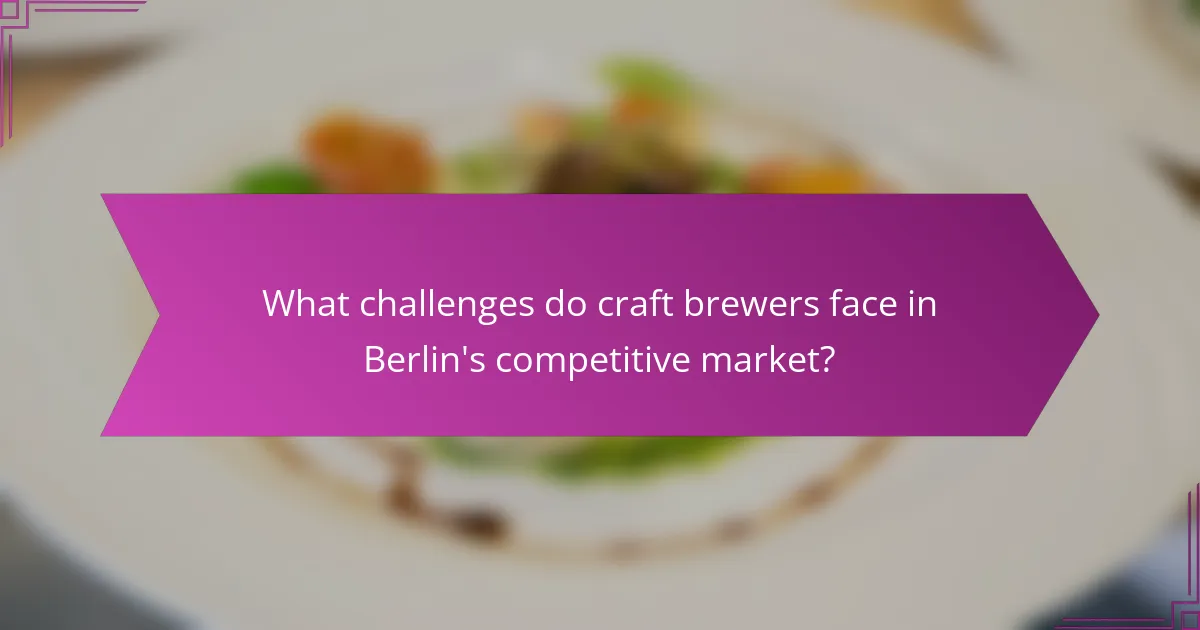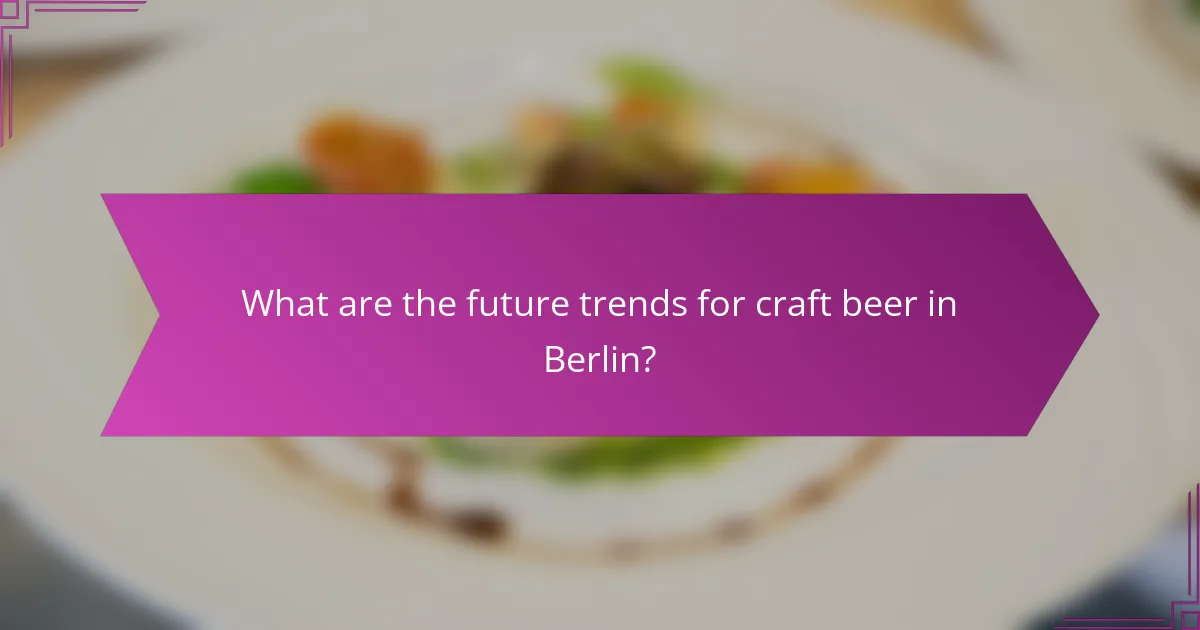Berlin’s craft beer scene offers a rich tapestry of brewing techniques, popular styles, and immersive tasting experiences. Key methods like decoction mashing and barrel aging enhance flavor and quality. Notable styles include Berliner Weisse, Hefeweizen, and IPA, each providing unique tasting experiences. Engaging with local breweries through tours and beer festivals fosters a deeper appreciation of this vibrant culture.

What are the key brewing techniques used in Berlin’s craft beer scene?
Berlin’s craft beer scene employs various key brewing techniques that enhance flavor and quality. Notable methods include decoction mashing, which extracts richer malt flavors, and fermentation with unique yeast strains that contribute distinct aromas. Many breweries also experiment with barrel aging to develop complex profiles. Additionally, dry hopping techniques are popular for maximizing hop aroma without adding bitterness. These techniques reflect Berlin’s innovative approach to craft beer, setting it apart in the global market.
How do local ingredients influence brewing methods?
Local ingredients significantly enhance brewing methods by introducing unique flavors and aromas. In Berlin, breweries often incorporate locally sourced grains, hops, and even fruits, reflecting regional tastes. This practice not only supports local agriculture but also fosters creativity in crafting distinctive beer styles. For example, the use of Berlin’s renowned malt can lead to a richer, more complex taste profile in lagers and ales. Additionally, seasonal ingredients can inspire limited-edition brews, keeping the beer scene dynamic and engaging for consumers.
What role does fermentation play in craft beer production?
Fermentation is crucial in craft beer production as it transforms sugars into alcohol and carbon dioxide. This process also develops complex flavors and aromas, contributing to the unique character of each brew. Different yeast strains are employed, influencing the beer’s taste profile and mouthfeel. For example, top-fermenting yeasts are used for ales, while bottom-fermenting yeasts are used for lagers. Additionally, fermentation temperature and duration can vary, affecting the final product. In Berlin’s craft beer scene, brewers often experiment with fermentation techniques to create innovative styles that reflect local tastes.
Which innovative brewing practices are emerging in Berlin?
Innovative brewing practices in Berlin include barrel-aging, wild fermentation, and the use of locally sourced ingredients. These techniques enhance flavor profiles and create unique tasting experiences. Emerging breweries are experimenting with hybrid styles, combining traditional and modern methods. Additionally, collaborations between brewers encourage creativity and innovation in craft beer production.

What popular styles of craft beer are favored in Berlin?
Craft beer in Berlin features popular styles such as Berliner Weisse, Hefeweizen, and IPA. Berliner Weisse is a low-alcohol, tart wheat beer favored for its refreshing qualities. Hefeweizen, a traditional German wheat beer, is known for its fruity and spicy flavors. IPAs, with their hoppy character, have gained immense popularity among craft beer enthusiasts. Other notable styles include Kölsch and Stout, each offering unique tasting experiences that reflect Berlin’s vibrant brewing culture.
How do traditional German styles adapt to modern tastes?
Traditional German beer styles have evolved to meet modern tastes by incorporating innovative brewing techniques and diverse flavor profiles. Craft breweries in Berlin experiment with local ingredients while respecting historical methods. This fusion creates unique variations of classic styles, such as hoppy lagers and fruit-infused wheat beers. As a result, traditional styles gain new appeal, attracting a wider audience.
Which unique styles are exclusive to Berlin breweries?
Berlin breweries are known for unique styles like Berliner Weisse, a tart wheat beer, and Gose, a sour and salty ale. These styles reflect local traditions and innovative brewing techniques. Berliner Weisse typically has a low alcohol content of around 3%, making it refreshing. Gose, originating from Leipzig but embraced in Berlin, features coriander and salt, offering a distinctive flavor profile. Other exclusive styles include craft lagers and IPAs that showcase local hops and ingredients, contributing to Berlin’s vibrant craft beer scene.
What seasonal variations can be found in local craft beers?
Local craft beers in Berlin exhibit distinct seasonal variations, influenced by ingredients and brewing techniques. In spring, lighter styles like wheat beers emerge, featuring fresh, floral notes. Summer brings fruity ales and refreshing lagers, perfect for warm weather. Autumn introduces spiced beers, often incorporating seasonal ingredients like pumpkin. Winter showcases rich stouts and dark ales, providing warmth with robust flavors. These variations reflect local brewing creativity and seasonal ingredient availability, enhancing the tasting experience throughout the year.

How can one experience craft beer tasting in Berlin?
To experience craft beer tasting in Berlin, visit local breweries, participate in guided tastings, and explore beer festivals. Berlin boasts a vibrant craft beer scene with unique brewing techniques and a variety of popular styles.
Local breweries often offer tours that showcase their brewing processes, allowing you to taste fresh beers on-site. Engaging with knowledgeable staff enhances the tasting experience, providing insights into flavor profiles and food pairings.
Beer festivals in Berlin, such as the Berliner Bierfestival, feature numerous craft beer vendors, allowing you to sample a wide range of styles. This social atmosphere fosters interaction with fellow beer enthusiasts and brewers.
Consider joining a craft beer tasting tour, which often includes visits to multiple breweries and bars. These tours provide a curated experience, showcasing the best of Berlin’s craft beer offerings while ensuring a diverse tasting journey.
What are the best breweries and taprooms for tasting experiences?
Some of the best breweries and taprooms in Berlin for tasting experiences include Berliner Kindl Brauerei, BRLO Brwhouse, and Berliner Pilsner. These venues offer unique craft beer styles and immersive tasting experiences. Berliner Kindl focuses on traditional German brewing techniques, while BRLO Brwhouse emphasizes innovative recipes. Berliner Pilsner provides a classic taste of Berlin’s brewing heritage. Each location features a range of tastings, allowing visitors to explore diverse flavors and brewing methods.
How do guided tastings enhance the appreciation of craft beer?
Guided tastings significantly enhance the appreciation of craft beer by providing structured experiences that deepen understanding. Participants learn about brewing techniques and flavor profiles directly from experts, which enriches their sensory evaluation. This educational aspect fosters a greater connection to the craft beer culture in Berlin, where diverse styles and innovative methods thrive. Furthermore, guided tastings often highlight unique attributes of specific brews, allowing attendees to discover rare flavors and ingredients. As a result, these experiences cultivate a more informed and engaged audience, leading to increased enjoyment and support for local breweries.
What tips can improve the craft beer tasting experience?
To enhance the craft beer tasting experience, focus on the following tips.
1. Choose the right environment: Select a quiet, comfortable space to fully appreciate the flavors.
2. Use proper glassware: Different styles benefit from specific glass shapes that enhance aroma and taste.
3. Take notes: Document your impressions of each beer to track preferences and flavors.
4. Pair with food: Complementary food can elevate the tasting experience and highlight specific flavors.
5. Experiment with styles: Explore various beer styles to discover unique flavors and brewing techniques.

What challenges do craft brewers face in Berlin’s competitive market?
Craft brewers in Berlin face intense competition, regulatory hurdles, and market saturation. The city’s craft beer scene is thriving, attracting new entrants, which increases rivalry. Breweries must navigate strict licensing laws and health regulations. Additionally, sourcing quality ingredients can be challenging due to demand. Effective marketing and branding strategies are essential to stand out in this crowded market.
How does regulation impact craft beer production?
Regulation significantly influences craft beer production by establishing quality standards and operational guidelines. In Berlin, local laws dictate brewing practices, ingredient sourcing, and labeling requirements, ensuring product safety and consumer trust. Compliance with regulations can enhance market access and foster innovation among breweries. Additionally, regulations may vary between regions, affecting the diversity of brewing techniques and styles. This regulatory landscape can shape the tasting experiences offered by craft breweries, as adherence to guidelines often promotes unique flavors and quality.
What are common misconceptions about craft beer in Berlin?
Many misconceptions exist about craft beer in Berlin, often stemming from a lack of understanding of its diversity. One common myth is that craft beer is only about high alcohol content. In reality, craft breweries focus on flavor, balance, and innovation, producing a wide range of styles with varying alcohol levels. Another misconception is that all craft beer is hoppy or bitter. While IPAs are popular, Berlin’s craft scene includes styles like stouts, porters, and sours, showcasing a spectrum of tastes. Additionally, some believe that craft beer is significantly more expensive than mass-produced options. However, many local breweries offer competitive pricing, reflecting their commitment to quality rather than inflated costs. Lastly, there’s a notion that craft beer is just a trend. In Berlin, the craft beer movement has deep roots, with a growing community dedicated to traditional and experimental brewing techniques.

How is the craft beer community in Berlin evolving?
The craft beer community in Berlin is rapidly evolving, driven by innovation and collaboration. New brewing techniques, such as barrel-aging and wild fermentation, are gaining popularity. Local breweries are increasingly experimenting with unique ingredients, creating diverse flavor profiles. The rise of craft beer festivals and tasting events fosters community engagement and showcases local talent. Additionally, the emphasis on sustainability is influencing brewing practices, with many breweries adopting eco-friendly methods.
What events and festivals celebrate craft beer culture?
Berlin hosts several events and festivals that celebrate craft beer culture. Notable examples include the Berlin Beer Week, Craft Beer Days, and the Berliner Bierfestival. These events showcase local breweries, innovative brewing techniques, and a variety of beer styles. Attendees can enjoy tastings, workshops, and meet the brewers. Each festival highlights the unique attributes of Berlin’s craft beer scene, fostering community engagement and appreciation for artisanal brewing.
How do social media and technology shape consumer engagement?
Social media and technology significantly enhance consumer engagement in the craft beer scene in Berlin. They facilitate direct communication between breweries and consumers, allowing for instant feedback and interaction. Social platforms enable breweries to showcase unique brewing techniques and popular beer styles, fostering community and brand loyalty. Additionally, technology aids in organizing tasting experiences, making them more accessible and appealing through virtual events and interactive content. Overall, these tools create a dynamic environment that encourages exploration and connection among craft beer enthusiasts.
What role do collaborations among breweries play in innovation?
Collaborations among breweries significantly enhance innovation in craft beer. By pooling resources and expertise, breweries can experiment with new ingredients and techniques. These partnerships often lead to unique beer styles that reflect diverse brewing traditions. For instance, joint projects can result in limited-edition brews that attract attention and foster community engagement. Additionally, collaborations can streamline production processes, allowing for greater efficiency and creativity. As a result, the craft beer scene in Berlin thrives on these cooperative efforts, continuously evolving with fresh ideas and flavors.

What are the future trends for craft beer in Berlin?
Craft beer in Berlin is evolving with trends focusing on sustainability, innovative brewing techniques, and diverse flavor profiles. Breweries are increasingly adopting eco-friendly practices, such as using local ingredients and reducing waste. Popular styles include hazy IPAs and sour ales, which appeal to adventurous palates. Tasting experiences are becoming more interactive, with brewery tours and tasting events emphasizing education and community engagement.
How is sustainability influencing brewing practices?
Sustainability is significantly shaping brewing practices in Berlin’s craft beer scene. Breweries are adopting eco-friendly methods, such as using renewable energy and sourcing local ingredients. This shift not only reduces carbon footprints but also enhances flavor profiles by utilizing regional produce. Additionally, many breweries are implementing water conservation techniques and waste management systems, contributing to a circular economy. These practices resonate with consumers, who increasingly prefer brands committed to environmental stewardship.
Which new market segments are emerging for craft beer?
Emerging market segments for craft beer in Berlin include non-alcoholic options, innovative flavor profiles, and local collaborations. Non-alcoholic craft beers are gaining popularity among health-conscious consumers. Unique flavor profiles, such as fruit-infused and barrel-aged varieties, attract adventurous drinkers. Collaborations between local breweries and food artisans enhance tasting experiences, creating niche markets. These trends reflect a shift in consumer preferences towards diversity and quality in craft beer.
What innovations in flavor profiles can we expect?
Innovations in flavor profiles for craft beer in Berlin include the use of local ingredients, experimental yeast strains, and barrel-aging techniques. These advancements enhance complexity and uniqueness in taste. For example, brewers are incorporating regional fruits and herbs, resulting in distinctive seasonal offerings. As a result, beer enthusiasts can expect a diverse range of flavors that reflect Berlin’s vibrant culture and brewing creativity.
What best practices should new brewers consider when entering the market?
New brewers should focus on quality, consistency, and understanding their market to succeed. Prioritize sourcing fresh ingredients, mastering brewing techniques, and maintaining sanitation. Engage with the local craft beer community to gain insights and feedback. Develop a unique selling proposition to differentiate your brand in Berlin’s competitive landscape.



